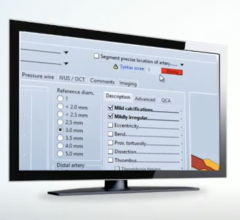“I don’t trust anything that’s being portrayed in the marketing brochures and will believe it only when the solution is implemented and adopted,” said a cardiologist at a recent steering committee meeting for a luminary healthcare organization I attended. While both blunt and bold, it resonated with me as it accurately summarized the
cardiovascular information and imaging systems (CVIS) market, as well as my own experience with various CVIS deployments. It is highly likely that this physician was speaking out of frustration, having recently experienced a poor CVIS implementation that resulted in this level of distrust.
As one of the key decision-makers for their organization, I’m sure this physician’s due diligence efforts will significantly increase for future projects. However, while due diligence certainly plays an important role in the success of any project, an often overlooked but equally critical success factor is an organization’s readiness to absorb enterprise-level initiatives. No CVIS solution in the market will be a perfect fit until a clear strategy with specific requirements is defined, and the entire organization is ready to move forward together.
I have had the privilege of participating in a number of enterprise CVIS projects, performing initial system and workflow analysis, CVIS procurements with RFP and the overall system implementation. Throughout my experience I have learned that no two projects are identical, and each project phase requires various stakeholders, resources and effort. While each organization and CVIS solution brings its own unique set of challenges, I have noticed several consistent variables on both the vendor and provider side that need to be evaluated and considered before moving forward with an enterprise CVIS initiative.
Rapidly Evolving EHR CVIS Modules
In the last few years, electronic health record (EHR) vendors have dramatically improved their CVIS functionality. By offering a single-application experience, system and data consolidation, and reduced licensing costs, EHR CVIS solutions have become a viable system of choice and a significant competitor for incumbent CVIS solutions in the market. While some gap-filling may still be required through third-party integrations, such as image management and viewer applications, providers are increasingly concerned that the benefits outweigh the cost and risk associated with introducing a completely new application.
Some of these benefits include:
• A single user interface that provides access to cardiovascular functionality and data alongside the complete patient record.
• Reduced licensing fees, as the cost of a CVIS module may already be included with an enterprise EHR license or could be made available at a minimally incremental cost.
• Reduced complexity and maintenance effort/cost within the IT department by reducing the number of disparate systems and vendors involved.
• A centralized platform for improved data mining and analytics to inform clinical and business decisions.
As EHR vendors continue to evolve their CVIS capabilities, they will increasingly infringe on the market share of traditional standalone CVIS solutions.
(In)Complete CVIS Solutions
Most healthcare providers are generally looking to implement a single-vendor solution to consolidate disparate systems and data retention points and ultimately improve data integrity, optimize end-user workflow and reduce overall support costs. While vendor marketing departments often describe seemingly complete solutions with an impressively wide range of capabilities, providers continue to encounter functional deficiencies and limitations that call for costly and sometimes inefficient gap-filling measures, ranging from workflow redesign to introducing additional vendors and systems.
There is a consistent list of gaps that providers often encounter as they embark on the CVIS implementation journey, which include:
• Lack of natively integrated modules for seamless workflow, data synchronization and complete analytics (i.e. inventory management, billing and analytics).
• Partial adoption of key reporting modules introducing third-party applications (i.e. invasive vascular, neurovascular and electrophysiology reporting).
• Need for third-party integration due to limited CVIS functionality (i.e. registries and advanced visualization).
• Inability to ingest comprehensive cardiovascular data for real-time business and quality reports.
To ensure a successful CVIS project meets clinical, technical and fiscal objectives, provider organizations need to ensure thorough due diligence is performed prior to putting pen to paper with any vendor, including:
• Detailed hands-on review of clinical functionality.
• In-depth analysis of the vendor’s technology.
• Evaluation of the vendor’s ability to successfully deliver on any future roadmap commitments.
• Reference site visit with similar size and service delivery where vendor’s technology is implemented.
Unique Challenges Within Invasive Cardiac Service Lines
Contrary to noninvasive workflow, where a physician may be situated at a reading workstation for several hours, workflow for invasive service line physicians is quite different. First, physician reporting is typically completed shortly after the intervention is complete. Second, the reporting module needs to offer a seamless workflow that can transfer all image, measurement and other discrete data from acquisition devices, and support staff modules to the EHR and/or other clinical data repositories in a relatively short time frame. If the CVIS system of choice introduces additional steps, delays in access or unnatural workflow, then physician adoption may be in jeopardy.
Engaging invasive cardiologists and vascular physicians in the early stages of system requirement definition and selection is a critical factor for success. Organizations need to identify physician champions early-on who are willing to support the organization’s strategy and collaborate on CVIS projects. While every physician is subject to ongoing healthcare changes and a revolving door of new system upgrades and installs, some are more open to embracing change where others find it more challenging and frustrating. Having individuals who can keep an open and objective perspective during strategy definition, ensure that selected functionality will improve the overall workflow, and can effectively articulate the benefits and changes to their colleagues, is key to reinforcing a culture that embraces positive change and innovation.
The Innovation-adoption Paradox in CVIS
Healthcare organizations are rapidly evolving, and as such their technology must be agile enough to swiftly adapt to shifting clinical workflow and technical requirements and scale to accommodate growth. An inability to do so limits the competitiveness of provider organizations within their regional market, negatively impacts cost and care quality, and creates compounded frustration for both providers and patients over time. Any vendor who has implemented core systems within the healthcare space has a unique opportunity to either elevate their client organizations to the next level of sophistication or create technical roadblocks that hinder progress and growth.
Often, I find that healthcare providers are looking to their vendors to present, deliver and continuously optimize their CVIS solutions. While this strategy appears to work during the procurement phase, eventually providers are faced with key technical and clinical decisions for system and workflow design, integration, data management standards, business continuity and more. Thus, it is critical that healthcare organizations are collectively ready to embark on the enterprise CVIS journey alongside their vendor of choice. Having a clearly defined strategy that provides well-defined technical, clinical and business requirements will help ensure a smooth and successful project.
However, having a strategy alone is not enough. The paradox between healthcare vendors and providers is that while providers call for more innovation from vendors, they are too often ill-equipped to adopt the innovations they so desire. If healthcare organizations want to provide industry leading care services, they must be prepared to adopt new technologies offered by vendors and integrate them into the clinical environment. This requires moving beyond vision and strategy toward strong governance with representation across clinical, technical and business functions, well-defined and agile change management policies, and a culture that supports continuous improvement and innovation.
To establish a mutually beneficial vendor-provider relationship both parties need to establish trust and form a shared vision and roadmap that addresses current and future CVIS needs, considering market direction, regulatory changes, evolving standards and ever-maturing healthcare technology.
It Takes Two to Tango With CVIS Implementations
In conclusion, it is safe to say that just like other clinical applications, CVIS solutions will continue to evolve as the industry experiences technical, clinical, regulatory and financial changes. How each healthcare organization and industry vendor choose to approach the market will define the next several years. I have seen both successful implementations and failed ones, and the difference comes down to how each entity approached the project. It truly takes both sides to collaborate for successful results. Vendors — even if your CVIS solution does not yet offer or meet all requirements up-front, a well-established roadmap with ongoing innovation will build the necessary confidence to keep clients' trust. For providers — preparing your healthcare organization to select and implement an innovative CVIS will ensure you avoid imminent disaster and never-ending delays and adoption issues.
Editor's note: Val Kapitula, RT(R), PMP, CIIP, is a healthcare IT consultant/partner at Paragon Consulting Partners, a healthcare IT advisory and consulting firm that focuses on having fun and doing right by its clients in healthcare. Having worked in medical imaging and health IT consulting over 19 years, he brings pertinent experience to any enterprise imaging, PACS replacement and CVIS initiatives. More information is available at pcpimaging.com.



 November 06, 2025
November 06, 2025 









